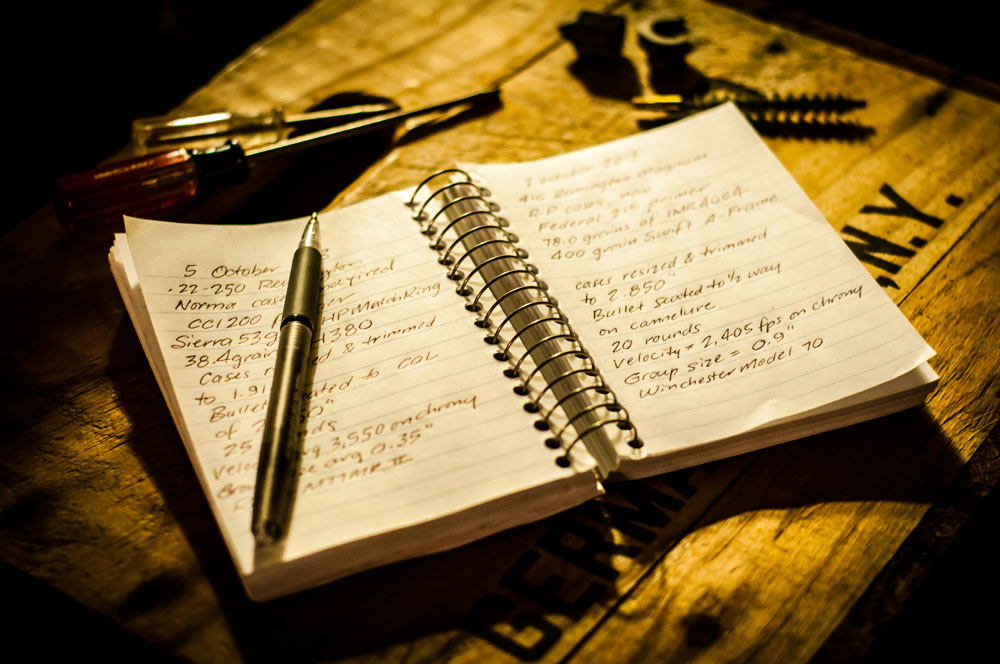
Keeping your reloading bench clean and organized is paramount to safe and effective handloading.
We all form habits, be they good or bad.
I’d like to give some advice that you may already adhere to, but I’ll sleep better having shared it with those of you who are new to reloading. Let’s form good habits, and stick to them, please.
Keeping a clean and tidy reloading bench is a must. Owning a custom ammunition shop, I have the privilege of loading many different cartridges in a number of configurations for my customers, which is awesome. So come safari season and the North American fall hunting seasons, things get rather hectic around here. I do my best to keep the Laboratory as neat and organized as I can, but it isn’t easy.
When you’re dealing with multiple calibers and cartridges that require different primers, powders and bullets, confusion lurks around every corner. As a self-imposed rule, I only keep the items I’m using for the particular load at hand on the bench: one box of primers, one canister of powder, one set of dies and one type of bullet at a time. This prevents any possible mix up, and the resulting dangerous load. It requires digging out new stuff for each project, which gets to be a pain in the butt, but in the name of safety I’ll deal with that.
Keeping your tools clean is a must also. Dirty, gummed up reloading dies can produce inaccurate ammunition. I keep a good supply of cotton swabs and a bottle of solvent – like Hoppe’s No. 9 – on hand for a quick cleanup of my dies.
As things start to slow down, I actually give my dies a nice warm bath in the ultrasonic cleaner to remove all of the gunk that builds up from the flakes of brass, nickel, copper and lead as it mixes with the case lubricant. You’ll be surprised what comes out of them!
Storing components can become a nightmare if you let it get out of hand. I keep my projectiles organized by caliber, and within each caliber by bullet weight. By keeping things well organized, I know just where to look for whatever I’m after.
Brass cases are organized in the same manner. If they’re once fired, I clearly mark the bag or container with the cartridge name so I can find them at a glance. Heavy duty freezer bags or empty coffee canisters (especially the newer plastic ones) make a great storage method for brass cases.
Keep your powder in a dry, dark place, safe from any possibility of sparks or open flame. And please, don’t ever store powder in a gun safe. God forbid it were to ignite, you’ve just created a half-ton bomb, a rather insalubrious notion! I keep my primers well organized and separated to avoid grabbing the wrong size or type of primer. And I keep them well away from the powder canisters.
When I store my reloading dies in their handy plastic boxes, I save the little silica gel packets you find in bags of beef jerky and put them in the die box. This draws all the moisture away from the dies and helps prevent rust. I also keep the presses well lubricated with gun oil so they don’t rust. You’d be surprised at how quick things can get rusty in the humid summer months here in Upstate New York.
I screwed a narrow strip of plywood to the wall and drove little finishing nails about 1.5” apart to store all my different shell holders. They are clearly labeled in permanent marker by number, and I even jotted down which cartridge they are appropriate for. Saves an awful lot of time, and is much easier than digging through a pile of shell holders.
Not everyone can have a loading area that is removed from the comings and goings of daily life, but do your best. What you want is a well lit space, as distraction-free as possible. Turn the cell phone off (you’ll live, trust me!), and keep the children at bay. “Oops” is a word that can lead to disaster in the reloading world.
Keep diligent records, please. After all the hard work that we reloaders go through, if you were to lose your load data, well, I’m getting teary-eyed just thinking about it. My notebook is invaluable to me, and I even keep things backed up on my computer.
One last point, and this may be the most important of all: Never mix alcohol with reloading. It just doesn’t work.
You all know the guy who likes to crack a beer or sip whiskey while reloading. Don’t do it, please. It can be tough enough get things right while sober; reloading while under the influence of your particular form of recreation can lead to trouble. Save it for when the powder and dies are all put away!
Next Step: Get your FREE Printable Target Pack
Enhance your shooting precision with our 62 MOA Targets, perfect for rifles and handguns. Crafted in collaboration with Storm Tactical for accuracy and versatility.
Subscribe to the Gun Digest email newsletter and get your downloadable target pack sent straight to your inbox. Stay updated with the latest firearms info in the industry.